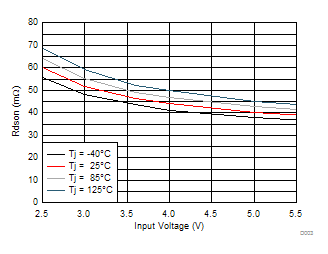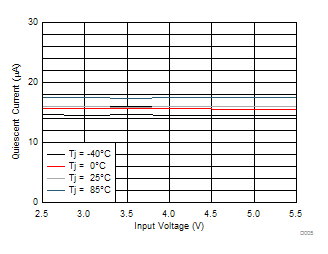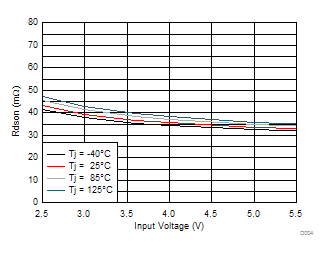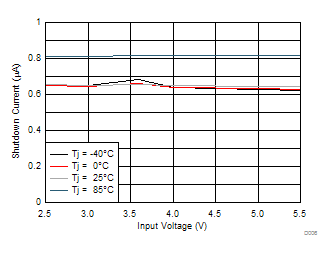SLVSDD3A March 2016 – January 2017 TLV62095
PRODUCTION DATA.
- 1 Features
- 2 Applications
- 3 Description
- 4 Revision History
- 5 Pin Configuration and Functions
- 6 Specifications
- 7 Detailed Description
- 8 Application and Implementation
- 9 Power Supply Recommendations
- 10Layout
- 11Device and Documentation Support
- 12Mechanical, Packaging, and Orderable Information
パッケージ・オプション
メカニカル・データ(パッケージ|ピン)
- RGT|16
サーマルパッド・メカニカル・データ
- RGT|16
発注情報
6 Specifications
6.1 Absolute Maximum Ratings(1)
| MIN | MAX | UNIT | ||
|---|---|---|---|---|
| Voltage at pins(2) | PVIN, AVIN, FB, SS, EN, DEF, VOS | – 0.3 | 7 | V |
| SW (DC), PG | – 0.3 | VIN+0.3 | ||
| SW (AC, less than 10 ns)(3) | – 3.0 | 10 | ||
| CN, CP | – 0.3 | VIN+7.0 | ||
| Sink current | PG | 1.0 | mA | |
| Operating junction temperature range, TJ | – 40 | 150 | °C | |
| Storage temperature, Tstg | – 65 | 150 | °C | |
(1) Stresses beyond those listed under absolute maximum ratings may cause permanent damage to the device. These are stress ratings only, and functional operation of the device at these or any other conditions beyond those indicated under recommended operating conditions is not implied. Exposure to absolute-maximum-rated conditions for extended periods may affect device reliability.
(2) All voltage values are with respect to network ground pin.
(3) While switching.
6.2 ESD Ratings
| MAX | UNIT | |||
|---|---|---|---|---|
| V(ESD) | Electrostatic discharge | Human body model (HBM), per ANSI/ESDA/JEDEC JS-001, all pins(1) | ±2000 | V |
| Charged device model (CDM), per JEDEC specification JESD22-C101, all pins(2) | ±500 | |||
(1) JEDEC document JEP155 states that 500-V HBM allows safe manufacturing with a standard ESD control process.
(2) JEDEC document JEP157 states that 250-V CDM allows safe manufacturing with a standard ESD control process.
6.3 Recommend Operating Conditions
| MIN | MAX | UNIT | ||
|---|---|---|---|---|
| VIN | Input voltage range | 2.5 | 5.5 | V |
| TJ | Operating junction temperature | -40 | 125 | °C |
6.4 Thermal Information
| THERMAL METRIC(1) | TLV62095 | UNIT | |
|---|---|---|---|
| VQFN (16 PINS) | |||
| RθJA | Junction-to-ambient thermal resistance | 47 | °C/W |
| RθJC(top) | Junction-to-case (top) thermal resistance | 60 | |
| RθJB | Junction-to-board thermal resistance | 20 | |
| ψJT | Junction-to-top characterization parameter | 1.5 | |
| ψJB | Junction-to-board characterization parameter | 20 | |
| RθJC(bot) | Junction-to-case (bottom) thermal resistance | 5.3 | |
(1) For more information about traditional and new thermal metrics, see the Semiconductor and IC Package Thermal Metrics application report.
6.5 Electrical Characteristics
VIN = 3.6V and TJ = 25°C (unless otherwise noted)| PARAMETER | TEST CONDITIONS | MIN | TYP | MAX | UNIT | |
|---|---|---|---|---|---|---|
| SUPPLY | ||||||
| VIN | Input voltage range | 2.5 | 5.5 | V | ||
| IQ | Quiescent current into PVIN and AVIN | EN = High, Not switching, FB = FB +5% | 20 | µA | ||
| ISD | Shutdown current Into PVIN and AVIN | EN = Low | 0.6 | µA | ||
| VUVLO | Undervoltage lockout threshold | VIN falling | 2.1 | 2.2 | 2.3 | V |
| Undervoltage lockout hysteresis | 200 | mV | ||||
| TSD | Thermal shutdown | Temperature rising | 150 | ºC | ||
| Thermal shutdown hysteresis | 20 | ºC | ||||
| CONTROL SIGNAL EN | ||||||
| VH | High level input voltage | VIN = 2.5 V to 5.5 V | 1 | 0.65 | V | |
| VL | Low level input voltage | VIN = 2.5 V to 5.5 V | 0.60 | 0.4 | V | |
| Ilkg | Input leakage current | EN = GND or VIN | 10 | 100 | nA | |
| RPD | Pull down resistance | EN = Low | 400 | kΩ | ||
| SOFT STARTUP | ||||||
| ISS | Softstart current | 7.5 | µA | |||
| POWER GOOD | ||||||
| VTH_PG | Power good threshold | Output voltage rising | 95% | |||
| Output voltage falling | 90% | |||||
| VL | Low level voltage | I(sink) = 1 mA | 0.4 | V | ||
| POWER SWITCH | ||||||
| RDS(on) | High side FET on-resistance | ISW = 500 mA | 50 | mΩ | ||
| Low side FET on-resistance | ISW = 500 mA | 40 | mΩ | |||
| ILIM | High side FET switch current limit | 4.7 | 5.5 | A | ||
| fSW | Switching frequency | IOUT = 3 A | 1.4 | MHz | ||
| OUTPUT | ||||||
| VOUT | Output voltage range | 0.8 | VIN | V | ||
| RDIS | Output discharge resistor | EN = GND, VOUT = 1.8 V | 200 | Ω | ||
| VFB | Feedback regulation voltage | IOUT = 1 A, PWM mode | 792 | 800 | 808 | mV |
| Line regulation | VOUT = 1.8 V, PWM operation | 0.016 | %/V | |||
| Load regulation | VOUT = 1.8 V, PWM operation | 0.04 | %/A | |||
6.6 Typical Characteristics
 Figure 1. High-Side FET On Resistance
Figure 1. High-Side FET On Resistance
 Figure 3. Quiescent Current
Figure 3. Quiescent Current
 Figure 2. Low-Side FET On Resistance
Figure 2. Low-Side FET On Resistance
 Figure 4. Shutdown Current
Figure 4. Shutdown Current